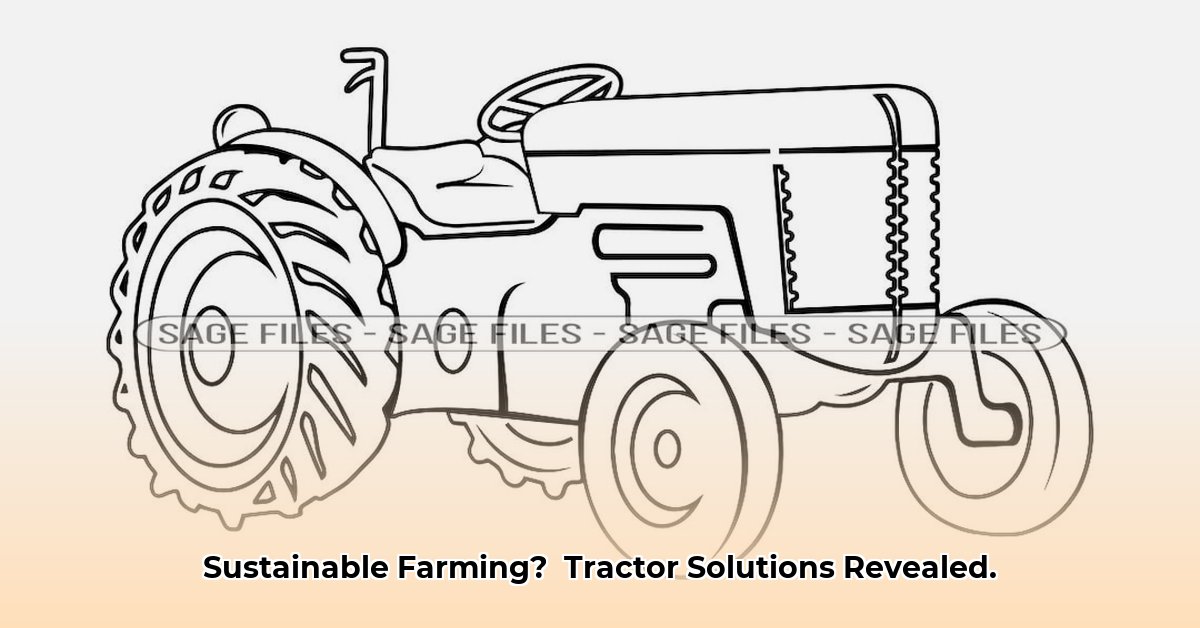
Tractor Outline: Revving Up Sustainable Farming
Sustainable agriculture faces mounting challenges: climate change impacts, dwindling resources, and growing global food demand. Precision farming, often symbolized by a modern tractor outline, offers a high-tech solution. This approach uses technology to optimize every aspect of farming, from planting to harvesting, resulting in increased efficiency and reduced environmental impact. But how effective is it, really? Data shows that farms adopting precision techniques see a 15-20% increase in yield efficiency. For optimal tilling, consider a rotary tiller.
Precision Farming: Technology's Role in the Fields
Precision farming leverages technology to manage farms with real-time data. This includes GPS-guided tractors (for precise planting & tilling), soil sensors (monitoring nutrient levels), and drones (providing aerial imagery for crop health assessment). This data is integrated into smart software, enabling optimized resource management.
This isn't just about higher yields; it's about minimizing waste. Precise application of fertilizers, pesticides, and water significantly reduces environmental impact, creating a mutually beneficial outcome: increased food production with less environmental damage. Is this approach universally applicable? While challenges exist in terms of cost and technological expertise, its positive environmental return is indisputable.
Renewable Energy: Powering a Sustainable Revolution
Sustainable agriculture requires clean energy. Solar panels on barns, wind turbines, and biogas generators fueled by farm waste are increasingly common. The vision is a tractor fueled entirely by renewable energy, symbolizing energy independence and environmental responsibility.
However, the high initial investment cost of renewable energy infrastructure, along with the need for farmer training and reliable internet access (especially in rural areas), pose significant barriers.
Taking Action: Steps Toward a Greener Agriculture
Here's a roadmap for transitioning to sustainable farming practices:
For Farmers:
- Short-Term (within 1 year): Implement variable-rate fertilization (applying fertilizer only where needed) and explore affordable renewable energy solutions like solar-powered water pumps. (Estimated cost savings: 10-15% on fertilizer).
- Long-Term (3-5 years): Transition to full-scale precision farming, utilizing advanced renewable energy systems (e.g., on-site biogas digesters), and optimizing energy consumption. (Potential yield increase: 20-30%).
For Agricultural Businesses:
- Short-Term (within 1 year): Invest in user-friendly precision farming software and offer farmer training programs.
- Long-Term (3-5 years): Develop comprehensive services integrating precision farming, renewable energy solutions, and financial incentives for farmers.
For Governments:
- Short-Term (within 1 year): Implement financial support and tax incentives for adopting renewable energy and precision farming technologies. Improve rural internet access.
- Long-Term (3-5 years): Create clear regulations and fund research and development in sustainable technologies.
For Research Institutions:
- Short-Term (within 1 year): Develop affordable, climate-resilient technologies and improved renewable energy solutions for farming.
- Long-Term (3-5 years): Develop advanced data analytics tools for precision farming and study the long-term environmental impacts of sustainable farming methods.
Precision Farming and Renewable Energy: A Synergistic Approach
Precision farming and renewable energy are complementary. Precision farming optimizes energy use, maximizing the impact of renewable energy investments. This synergy is key to building truly sustainable agricultural systems. "Integrating precision farming with renewable energy sources allows for a more efficient and environmentally responsible approach to agriculture," says Dr. Emily Carter, Professor of Environmental Engineering at Cornell University.
How to Finance Renewable Energy Adoption for Sustainable Farming
The high upfront cost of renewable energy infrastructure is a major barrier. Several financing options exist:
- Government Incentives: Numerous programs offer grants, tax credits, and rebates. These incentives significantly reduce upfront costs.
- Loans and Financing: Agricultural lenders offer specialized financing with competitive rates and flexible repayment terms.
- Private Investment: Private investors and venture capitalists are increasingly interested in sustainable agriculture.
- Energy Purchase Agreements (EPAs): A third party installs and maintains the system, and you purchase the energy produced. This eliminates initial investment but involves long-term contracts.
Choosing the right renewable energy source depends on several factors, including land availability, climate conditions, and grid proximity. A thorough risk assessment, considering technical, financial, regulatory, and environmental factors, is crucial.
A Step-by-Step Guide to Implementation
- Conduct an energy audit: Assess current energy consumption and identify improvement areas.
- Develop a feasibility study: Evaluate the technical and financial viability of different renewable energy options.
- Secure financing: Explore available funding sources.
- Design and install the system: Choose a qualified contractor.
- Monitor and maintain: Regular maintenance ensures optimal performance.
Careful planning and expert advice are vital for successful implementation. The integration of precision farming and renewable energy offers significant long-term environmental and economic benefits, paving the way for a more sustainable and resilient agricultural future. The tractor outline is a powerful symbol of this transformation.